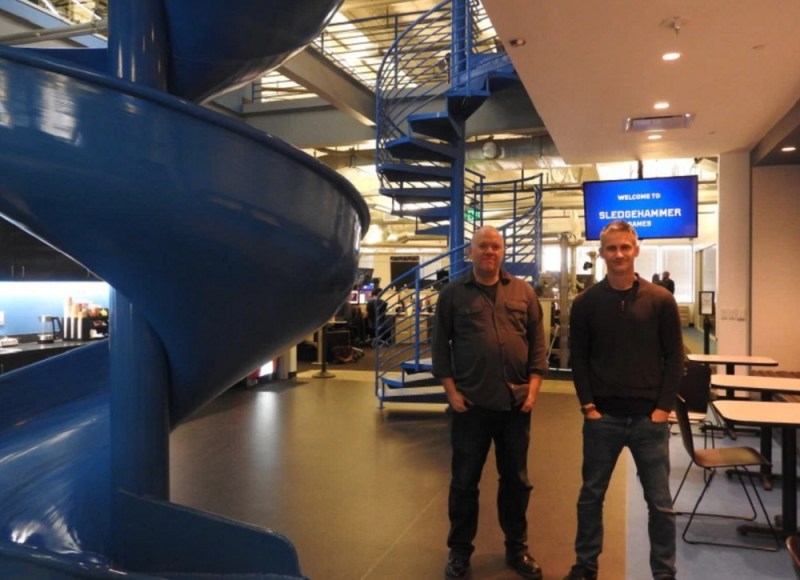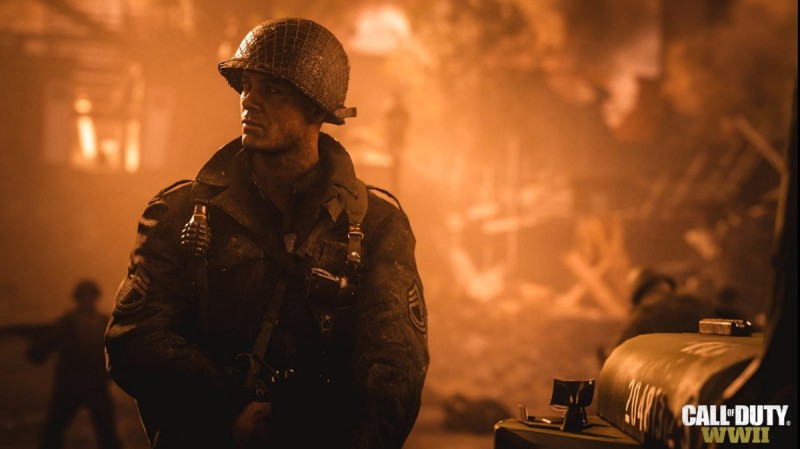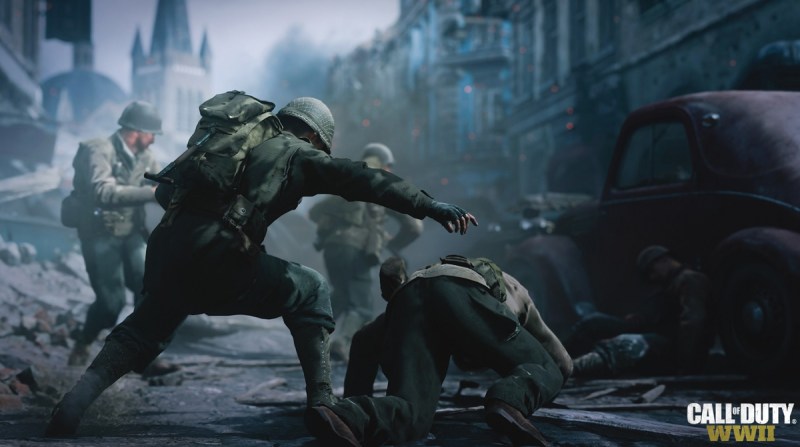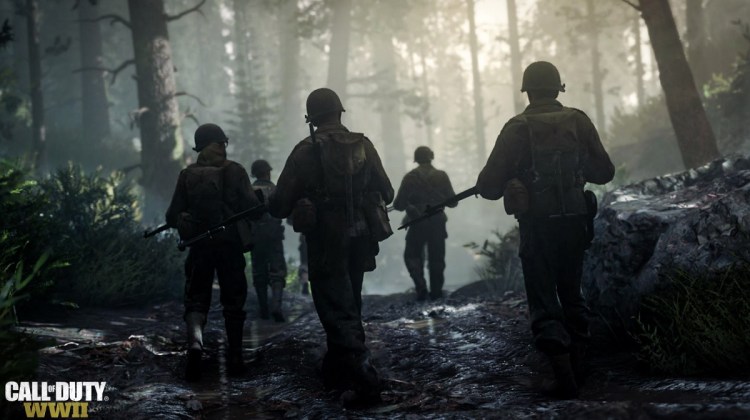Believe it or not, Call of Duty isn’t all about shooting and cool graphics. Sledgehammer Games is trying to ensure that its newly revealed Call of Duty: WWII has a compelling story.
That’s why the return to the roots of Call of Duty in the Second World War is such a big deal. It has such a wealth of historical material to weave into a story, with plenty of angles that haven’t been done over and over, according to Sledgehammer’s crew.
I sat down with Sledgehammer’s storytellers, senior creative director Bret Robbins and narrative director Scott Whitney at the game studio in Foster City, California. Their mission was to create characters and a narrative that showed how World War II was a “crucible that brought out the best and worst of people.”
June 5th: The AI Audit in NYC
Join us next week in NYC to engage with top executive leaders, delving into strategies for auditing AI models to ensure fairness, optimal performance, and ethical compliance across diverse organizations. Secure your attendance for this exclusive invite-only event.
“The main thing for me — and this speaks to all the cinematic moments we’re doing — we wanted to make sure you cared about the guys you were with,” said Robbins. “It’s not just being in an empty action sequence. There’s some kind of emotional connection to your squad. Some of the events that lead up to D-Day introduce your squad to you and give you a feel for them, so that maybe you’re a bit worried about them surviving alongside you.”
At the same time, the storytellers want to make sure that they told an honest and true story of what the war was really like for a generation that never experienced it.
Here’s an edited transcript of our interview.

Above: Call of Duty: WWII narrative leads Scott Whitney (left) and Brett Robins.
GamesBeat: Did you both start at the beginning of this project?
Brett Robbins: Yeah. I worked on Modern Warfare 3 and Advanced Warfare, and now this.
GamesBeat: Was World War II a given when you started? Or did you sort of talk yourselves into that setting?
Robins: We had come off of making Advanced Warfare. I think there was a feeling on the team of wanting to try a different direction. At the same time, the company was interested in going back to the roots of Call of Duty. The way the timing worked out for us, it felt like a good fit. We talked about it a lot, but at the end of the day it felt like a different, exciting direction to go in.
Scott Whitney: Also, clearly, there was fan appetite for it. It was the convergence of all those forces that made it seem like the right game at the right time.
GamesBeat: Technology is a lot better now. In some ways it can feel like a fresh telling. Was there something on the story side as well that you felt you needed to go back to?
Robbins: It was a mix of wanting to give some familiar elements to World War II, give the fans something that they remember, but on the new platforms now. Better graphics, better fidelity. But then also to tell our own story. We definitely have some historic battles and moments throughout the campaign, but then we’ve also invented a lot of new things. We’re showing some of the old stuff and then also bringing along new stuff.
GamesBeat: For D-Day, how would you have approached that particular scene, what they showed in the trailer?
Robbins: The main thing for me – and this speaks to all the cinematic moments we’re doing – we wanted to make sure you cared about the guys you were with. It’s not just being in an empty action sequence. There’s some kind of emotional connection to your squad. Some of the events that lead up to D-Day introduce your squad to you and give you a feel for them, so that maybe you’re a bit worried about them surviving alongside you. In general we’re trying to make any action sequence, any big cinematic sequence, have some kind of narrative relevance. That’s super important.
Whitney: That was an area of emphasis for the project as a whole, wanting to really dig deeper into the characters and their relationships, deliver that ensemble experience that was so much at the heart of the WWII stories we were most passionate about. Normandy is a good example, but throughout the game that’s a real area of focus.

Above: Call of Duty: WWII has stark imagery.
GamesBeat: Did a lot of thought go into choosing the particular unit as well?
Robbins: Going into the research for the game—World War II is such a huge conflict. You can enter it in all sorts of different ways. Early on we decided to do the American experience, and really quickly, researching the 1st, it was amazing to realize that this one division had walked through all these amazing historical events. Also, we wanted to tell a single squad’s story. That was important to us, having one soldier’s journey.
Now, we intersect with a lot of other characters. It’s an international story and an international game. But we really wanted to focus on his experience and the experience of his squad, his best friends and his commanders and so on.
GamesBeat: Is there a kind of history that you favored more? It does seem like this is very experience-focused, very gritty. The immersiveness of it seems to come through, at least in the trailer.
Whitney: I can’t remember where I read this quote, but one thing was this idea that war is a crucible that brings out the best and the worst in people. There was a desire on our part to accurately represent the richness of that experience, the subtleties, the nuance. Within there you have the best that man is capable of and the worst. To have that kind of clear-eyed approach to what we were doing was important.
Robbins: We were trying to be authentic and realistic to the times. The story deals with anti-Semitism. It deals with racism. It deals with subjects that maybe previous games haven’t. But they were an unfortunate reality of the time. We didn’t want to shy away from that. As soon as you start researching World War II you realize that atrocities happened. There are very dark chapters in that story. It felt like we’d be doing the war a disservice if we didn’t at least touch on some of those. We go into some pretty dark places over the course of the story, but it’s emotionally impactful, I think.
GamesBeat: I talked to the writers on Mafia III, which dealt with racism in the late ‘60s. One thing they said was very interesting, where they thought it would have been disrespectful or dishonest to sweep that under the rug.
Whitney: Yeah, I think there’s a similar sensibility here. As soon as you’re dealing with something—Advanced Warfare was a great game, but it was a game about an imagined future. As soon as you bear that extra weight of addressing real events that touched real people’s lives, there’s that extra burden to deliver a compelling and entertaining experience, but also one that’s truthful and honest.
Robbins: We didn’t want to sugarcoat anything. We didn’t want to do the Disneyland version of World War II. These things happened and we’re not going to look away from them.
GamesBeat: Choosing which scenes to deal with seems to become very important. Do you feel like you chose certain scenes, certain battles, for particular reasons? Hürtgen Forest, for example, was that trying to convey something in particular?
Robbins: Hürtgen Forest represented a very dark chapter in the war, where it was really grinding on. We were low on supplies, low on ammunition, low on men. There had been a sentiment before that experience, that battle, that we’d all be home by Christmas. As the war kept dragging on, morale was getting lower. By the time Hürtgen Forest shows up in our story, we’re getting to this emotional low point. We tried to pick historical beats that would fit the emotional arc of the story as closely as possible.

Above: Vehicles make a lot of noise in Call of Duty: WWII.
GamesBeat: Past Call of Duty games have taken some lessons from Hollywood, and even writers from Hollywood. Did you guys learn anything in particular from the movies?
Whitney: We’d be foolish not to take advantage of all the master storytellers out there, all the lessons we can learn from them. Certainly those are things that are both inspirational for us and things that have served, in some cases, for people that weren’t actually there to define our conception of the war. We cast a wide net in terms of — not just the obvious examples, but also looking at some lesser-known films — like a German take on the war, maybe. We’re reflecting all those kinds of things.
Robbins: We’re also just trying to get our finger on the pulse of pop culture and what’s out there currently. Looking at films like Fury and Hacksaw Ridge, any recent movies, just to see cinematic techniques, how they’re staging battles, what we can learn from them. Looking back at a movie from 30 years ago compared to a movie of today and seeing what the differences are like. You learn something from each one. But it’s important for us to immerse ourselves in what today’s audience thinks about the war, what’s out there right now.
Whitney: Right. Nothing about this should feel like a dry history lesson, my grandfather’s war. This is just as vital as it ever was.
GamesBeat: I know you’ve talked to historians. Have you also talked to veterans, done that kind of direct research?
Whitney: We do extensive direct research. One of the nice things about our military historian, in his service and writing his works and working at the WWII National Museum in New Orleans, he’s connected to a large network of veterans. We’re able to tap their experience and their primary source accounts. Through a combination of working with Marty as a filter to help us access that material, and then our own research, which is also extensive, we’re able to expose ourselves as much as possible to the actual stories and voices of guys who were there. There’s a richness and a texture that you can’t replace. Nothing can replace firsthand experience.
Robbins: We also did some travel, visiting historic battle sites.
GamesBeat: Battlefield 1’s storytellers focused on the lesser-known corners of the war, like the Middle East. It seems like there’s always an interest in that sort of thing, revealing something new, but at the same time people would ask how you could do World War II without D-Day.
Robbins: It’s like I said before about trying to give people some of the old and some of the new as well. The amazing thing to me is that the more we research World War II, we’re still uncovering stories about the war today. In our research we’ve learned about some events that have really just come to light in the last few years. We’ve put those in the game. There are stories that I don’t think many people have heard of before in here, but then there are also more familiar—you know, landing on Normandy, we’ve all heard about that. What’s our take going to be? How is that going to be different.
Whitney: Those are such classic elements that you do feel like it’s a sort of necessity to do them justice, to include them in the overall experience. But we also want to make sure that’s infused with elements that are new and fresh, things you’re maybe not as familiar with.
GamesBeat: You have women fighting in the game, and you didn’t have to make that up.
Robbins: Yeah, yeah. It’s interesting. We knew going into this that there would be something of a diversity challenge. You had mainly white men fighting on the American side. In writing the story we were looking for opportunities to bring in a more diverse cast of characters. Featuring the French resistance and the resistance leader, Rousseau, a woman French operative, and being able to play as her for a portion of the story, that was really exciting to us. Later on in the game your path intersects with an African-American squad and you fight alongside them. Just trying to find those moments in history that are historically accurate and could give us more diversity in the game, that was really important.

Above: The graphics have been taken up a notch in Call of Duty: WWII.
GamesBeat: Did you feel pulled in some way like, “I want to do this battle here, and this one, and this one over here,” but there’s no unit that could have realistically been in all of those places?
Whitney: We got pretty lucky early on in our research, finding a unit that just by a stroke of luck was managing to hit a lot of the highlights that, left to our own devices, we would have wanted to visit anyway. That’s part of the reason why they’re so legendary, and why it was so exciting to be able to tell their story a bit more completely. Just wrapping your head around the notion that this one group of guys traveled so much ground and saw all this pivotal action working their way east, it was a huge inspiration for us. It ended up working well as far as delivering all the spectacle you’d need for a Call of Duty game, built in.
GamesBeat: Has it been fun to show the game for the first time?
Robbins: It’s a lot of hard work, but when it pays off it’s pretty amazing. Seeing people’s reactions to it, especially for the first time, that’s always exciting. You get very close to the material, to the work. You forget that this is a huge blockbuster game that millions of people are going to experience. When you’re reminded of that, when you see something play a level for the first time and have a great reaction to it, it’s super rewarding.


